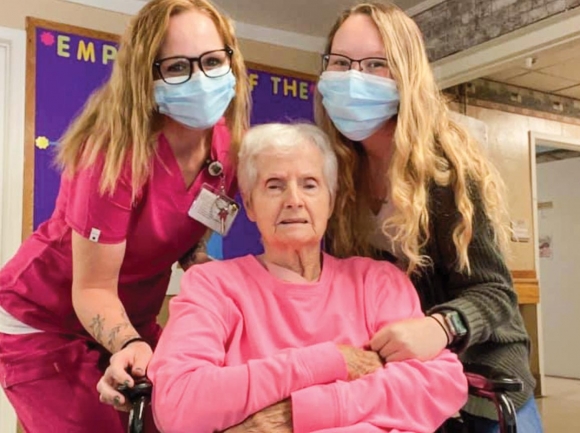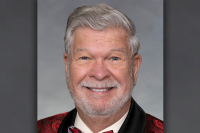Nursing homes face essential worker shortage
 Skyland Care Center staff members pose for a picture with a resident.
Skyland Care Center staff members pose for a picture with a resident.
Nursing homes and assisted living facilities were among the hardest hit during the COVID-19 pandemic. Now, they are facing another problem, one whose roots stem from pre-COVID times — staffing shortages.
An analysis by the American Health Care Association and the National Center for Assisted Living earlier this year estimated that the nursing home industry is expected to lose $94 billion over the course of the pandemic, and more than 1,800 facilities could close their doors. Closures are hard on vulnerable residents who are forced to move, their family members who must often travel farther to see their loved ones and dedicated caregivers who are out of a job.
“The survey results clearly indicate that the long-term care workforce is facing serious challenges,” Mark Parkinson, president and chief executive of AHCA/NCAL, said in a statement. “Lawmakers across the country must prioritize long term care to ensure the profession has the necessary resources to maintain a strong workforce. This begins with addressing chronic underfunding of Medicaid for nursing homes, which currently only covers 70 to 80% of the cost of care.”
Of the 616 nursing homes surveyed by AHCA/NCAL, 94 percent said they are experiencing a staffing shortage. Nearly every nursing home facility in Western North Carolina is currently hiring for multiple positions.
Both Silver Bluff Village in Haywood and Skyland Care Center in Jackson County are hiring for positions across the board. Nurses, nursing assistants, housekeepers and dietary staff are all needed.
“We are having difficulty finding staff, even from staffing agencies charging ridiculous wages. We are managing, only because our census is still down but to fully reopen, we are in need of eight nurses, including one open nurse manager position, 11 nursing assistants, three housekeepers and four dietary staff. Twenty-six open positions. I talk with most of the administrators in the region, and we are all in the same boat,” said Lisa Leatherwood, Silver Bluff Village Administrator.
Related Items
Skyland Care Center has also seen a dip in the number of people they serve.
“Well, we’ve already been kind of a little low from, just from the pandemic anyway, so that’s kind of worked in our favor, but we do see an increase in census numbers starting to pick back up so we definitely need our staffing numbers to pick back up,” said Mistie Cooley, Administrator at Skyland Care Center.
At this point, people are familiar with the signs on stores and restaurants communicating messages about closing early, reduced hours or longer wait times due to understaffing. At nursing home facilities where vital care is required around the clock, there is no option for reducing the workload.
“We’re running a lot of overtime. We’re asking people to work extra and pick up extra. Our department managers are taking up a lot of extra work,” said Cooley.
Despite the essential nature of these positions, healthcare workers other than doctors or nurses, over 80 percent of the healthcare workforce, were making less than a living wage pre-COVID. The majority of these workers are women and people of color. Average income for these healthcare workers was $13.48 an hour in 2020. The living wage for a single person without any children in North Carolina is $14.72 an hour.
“Pre-COVID, we were already struggling with nurses and CNAs, but not so much with other departments,” said Cooley.
Leatherwood noted the aging workforce, another pre-COVID issue exacerbated by the pandemic. There are over 120,000 nurses in the state of North Carolina. Their average age? 53.
“The average age for nurses in North Carolina is over 50 and that’s including all the 20-somethings that are just graduating and we just aren’t turning out enough nurses to fill that void,” said Leatherwood. “Same situation with nursing assistants. The number of people on the nurse aide registry isn’t growing but the number of jobs available are. We aren’t training enough NA’s to even fill the new positions, much less cover those opening up by folks saying, ‘forget it, I don’t want to do this anymore.’”
In an effort to fill the nursing void Leatherwood speaks of, as well as the need for non-nursing healthcare and support staff, nursing home facilities are having to get creative. At Skyland Care Center, administration has raised all hourly positions by at least $2 an hour.
“We’re offering sign-on bonuses for certain positions. We’re also offering flexible schedules. So, to try to draw the students in, and maybe they go to Western or Southwestern, we’re offering flexible schedules for them. Just trying to be as flexible as possible to attract people to want to work at skilled nursing facilities,” said Cooley.
Cooley also hopes the end to unemployment benefits will bring more people back into the nursing home workforce.
“I think there’s a lot of people still out on unemployment,” said Cooley. “I think that that’s probably the biggest hurdle of course. Post COVID, since the pandemic has started and we’re seeing it across the board in all departments I attribute that to people at home, not coming back to work for various reasons.”
“I think the pandemic forced people to re-evaluate their lives and whether or not what they were doing was making them happy,” said Leatherwood. “Some people chose to retire early, some decided to change fields especially due to the high risk of getting COVID, some people decided to take an indefinite leave of absence and some decided to stay home and collect unemployment especially considering the add-on benefits.”
The future of nursing homes is uncertain. According to the AHCA/NCAL survey, over half the nursing homes in the United States are operating at a loss and only a quarter of nursing homes are confident they can last a year or more. But Cooley is confident her facility will persist through current staffing shortages.
“We’ll just continue doing the best that we can. Hopefully the governor will change some of the laws as far as unemployment and things like that with the COVID pay and I’m hoping that will make a difference and just continuing to work hard as a team, until we can reach that point, where do we get more staff.”









